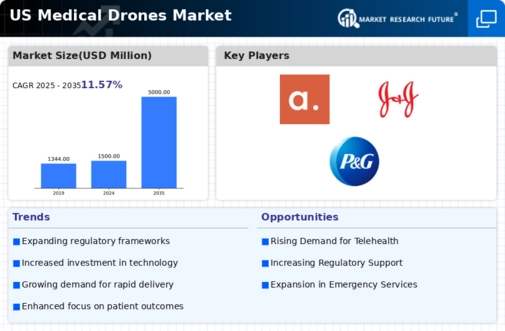Advancements in Drone Technology
Technological advancements are a driving force behind the growth of the medical drones market. Innovations in battery life, payload capacity, and navigation systems are enabling drones to operate more efficiently and effectively. For instance, the introduction of hybrid drones that can switch between different power sources is extending operational ranges and enhancing reliability. As these technologies continue to mature, the medical drones market is expected to benefit from improved performance and expanded applications, making drones a more viable option for healthcare logistics.
Supportive Regulatory Environment
A supportive regulatory environment is crucial for the growth of the medical drones market. Recent initiatives by the Federal Aviation Administration (FAA) to streamline regulations for drone operations are fostering innovation and adoption. These regulations are designed to ensure safety while promoting the use of drones in various sectors, including healthcare. As the medical drones market navigates these regulatory frameworks, the potential for expanded operational capabilities and increased investment will likely enhance the overall market landscape, encouraging more stakeholders to explore drone solutions.
Cost-Effectiveness of Drone Logistics
Cost-effectiveness is emerging as a significant driver for the medical drones market. The operational costs associated with traditional delivery methods, such as ground transportation, can be substantial, particularly in remote or hard-to-reach areas. Drones offer a more economical alternative, reducing delivery times and costs by up to 50% in some cases. This financial advantage is particularly appealing to healthcare providers and organizations looking to optimize their logistics. As the medical drones market continues to evolve, the potential for cost savings will likely encourage more healthcare facilities to adopt drone technology for their supply chain needs.
Increased Focus on Emergency Preparedness
The medical drones market is increasingly influenced by a heightened focus on emergency preparedness. Natural disasters, public health emergencies, and other crises necessitate rapid medical response capabilities. Drones can deliver critical supplies to affected areas quickly, bypassing obstacles that may hinder traditional transport methods. This capability is particularly relevant in the US, where the Federal Emergency Management Agency (FEMA) has recognized the potential of drones in disaster response. The medical drones market is thus likely to see increased investment and development in drone technology tailored for emergency applications, enhancing overall healthcare resilience.
Rising Demand for Timely Medical Deliveries
The medical drones market is experiencing a notable surge in demand for timely medical deliveries, particularly in urban and rural settings. The ability to transport medical supplies, such as vaccines, blood products, and essential medications, within minutes rather than hours is becoming increasingly critical. This demand is driven by the need for rapid response in emergencies, where every second counts. According to recent data, the market is projected to grow at a CAGR of approximately 25% over the next five years, indicating a robust expansion. The medical drones market is thus positioned to play a pivotal role in enhancing healthcare delivery systems, especially in areas with limited access to traditional transportation methods.














Leave a Comment